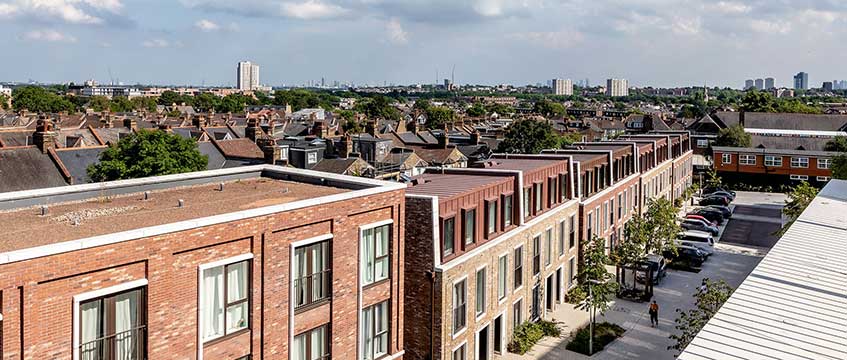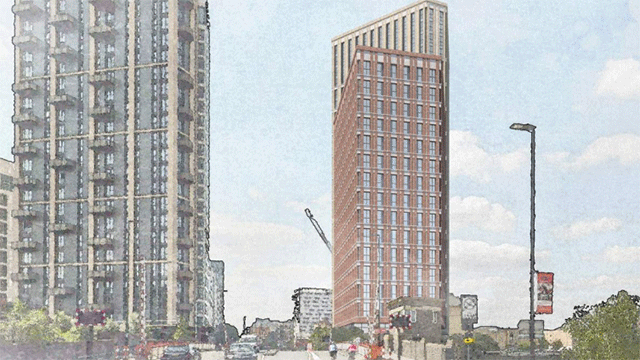Pocket Living is launching a build-to-rent arm after 15 years specialising in affordable home ownership.
The developer, which is majority owned by US-based housing provider Related, aims to provide an affordable rental option for young professionals in London. The strategy would see Pocket deliver an equal number of BTR homes compared with its core for-sale product, with a shift to focus on larger developments.
Pocket is planning a debut scheme in Old Oak, west London, more than double the size of any previous development. The developer aims to build over 400 BTR homes at Atlas Wharf, at the former Quick Skips & Recycling site on Atlas Road, NW10. After agreeing to buy the site at the end of last year, the company has enlisted Grit Architects to work up plans, with a planning application due in the coming months.
Marc Vlessing, chief executive of Pocket Living (pictured in the slide show below), tells EG: “With the maturing of institutional investment around BTR on one hand and most of the BTR focus at the higher end of the market, there was scope for us to try and find a BTR format that would sit comfortably with Pocket’s for-sale brand.
“All of our stakeholders are pointing in the same direction, and one of our key stakeholders is our consumer. For our consumer, we know that a keenly priced rental product would get an awful lot of people into a home that they could consider their own for the long term.”
Deep pockets
As the owner of a 70% stake in Pocket Living, New York’s Related Companies is another key stakeholder. Formed over 40 years ago, Related has more than $50bn (£36bn) of assets owned or under development, including the 28-acre Hudson Yards. The BTR specialist initially bought a 50% stake in Pocket in 2016 before increasing this in 2019.
When it comes to funding the homes, Vlessing says Related is “a very, very substantial player, which at any point could step in and own this thing outright, if it wanted to”. He adds: “We have modelled it on the basis that that is definitely an option.” However, he is open to investment from the market and anticipates high demand for a new product.
Pocket specialises in providing affordable homes to first-time buyers on low to moderate salaries within the boundaries of a site’s local authority. Vlessing is very specific: the customer base is skewed towards 28 to 36-year-old professionals, often women, typically earning a salary of £28,000 to £40,000.
A combination of public investment via loans – initially with £20m from the Greater London Authority in 2013 – lower-priced land and smaller homes in denser schemes allows Pocket to offer a 20% discount to market sale prices to buyers that fit the bill. For example, it is currently selling homes in Barking, east London, for less than £200,000.
The rental product will target that demographic, but include renters, which the market currently doesn’t cater to. “I would be very surprised if our rents started above £1,200 [per month]. That would be our aim,” says Vlessing. “I challenge you to find quality BTR in good central locations for anything much under £1,500 to £1,700.”
To be able to offer that, schemes need to provide at least 250 to 300 homes, Vlessing says. The higher end will also allow Pocket to work with larger contractors. After 15 years, he says the hardest challenge has been working with small outfits with weaker balance sheets. The increase in size follows the trajectory for Pocket, which now develops sites that provide close to 200 homes each, having initially begun with schemes of around 50.
Building bigger
Vlessing anticipates the BTR business could grow to develop 500 to 700 BTR homes a year. This compares with current levels of around 500 for-sale homes a year. Pocket is on course to complete its 1,000th home this year, having typically focused on much smaller schemes, and hopes to increase this to more than 2,500 by 2027.
“As you grow up from being an ‘S’ in the SME spectrum, you can’t just keep spinning the same plate,” says Vlessing. “We are extremely grateful to Homes England and the GLA for the funding advantage that they gave us to build Pocket out to the point where we have now built our 1,000th home. But, the truth of the matter is, they wouldn’t want us to just depend on them and that model for our existence either.”
With the introduction of the First Homes tenure, which Vlessing describes as a “carbon copy” of Pocket’s for-sale model, he believes future schemes will offer a spread of options. There is the Pocket core discount sale, the First Homes deeper discount, the rental and discount market rent.
“We just need to build more,” he adds. “In some locations it’s going to be better and easier to build rental than it is to build for-sale, and in other locations it’s going to be easier to build for-sale.” Similarly, different places will lend themselves to schemes that are smaller, or increasingly larger.
Still, keeping his options open, Vlessing adds: “Those big developments may or may not benefit from a long-term annuity investment, from an institutional investor, or not.”
To send feedback, e-mail emma.rosser@eg.co.uk or tweet @EmmaARosser or @EGPropertyNews











